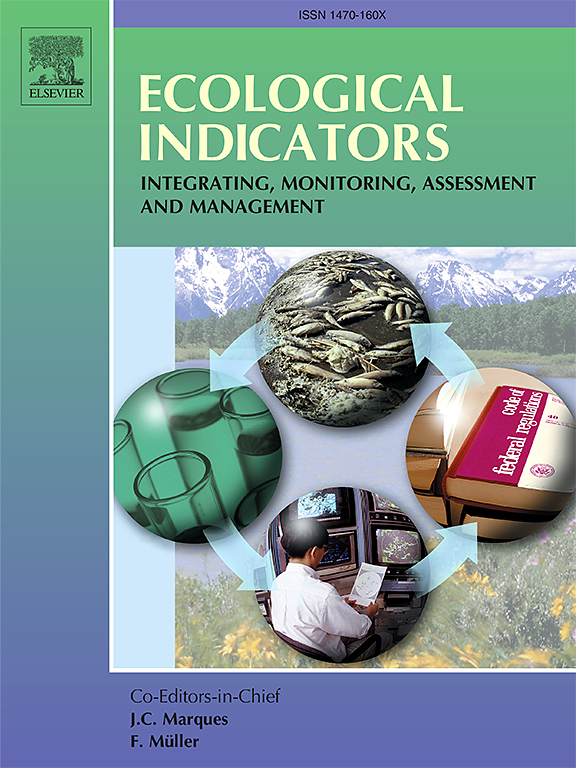水生态健康评价中多群落生物完整性指数的建立——以中国东部山区流域为例
IF 7
2区 环境科学与生态学
Q1 ENVIRONMENTAL SCIENCES
引用次数: 0
摘要
水生态健康评价为流域水资源管理、生态保护和修复提供科学依据。生物完整性指数(IBI)是一种流行的方法,但单一群落的IBI可能不能完全反映水生生态系统的健康状况。本研究提出了多群落生物完整性指数(Mc-IBI)作为区域流域尺度水生态系统健康评价指标。基于杭州中部山区小流域44个样点的底栖生物、浮游植物、浮游动物和附生藻类,建立了Mc-IBI。根据生物群落的分布特征,构建了包含137个潜在指标的候选指标池。通过分布范围分析、判别性检验和冗余性检验,选择底栖动物类群、桡足动物类群和Simpson指数等17个核心指标。利用t-SNE法降维后得到的低维空间确定每个采样点上各生物群落的权重,并根据这些权重赋值得到最终的Mc-IBI值。Mc-IBI评价的山区小流域生态健康状况为“良好”(63.58±8.52)。与单个ibi相比,Mc-IBI整合了多个生物群落,能够更全面地评价区域流域尺度的水生生态系统健康。本文章由计算机程序翻译,如有差异,请以英文原文为准。
Development of a multicommunity index of biotic integrity for ecological health assessments of water—A case study of a mountain watershed in eastern China
The evaluation of water ecological health provides a scientific foundation for water resource management, ecological protection, and restoration in river basins. The index of biological integrity (IBI) is a popular method, but a single-community IBIs may not fully reflect aquatic ecosystem health. In this study, a multicommunity index of biological integrity (Mc-IBI) was proposed as an indicator for aquatic ecosystem health assessment at the regional watershed scale. Mc-IBI was established based on benthos, phytoplankton, zooplankton, and epiphytic algae collected from 44 sampling sites in a mountainous small watershed in central Hangzhou (Zhejiang Province, China). A candidate indicator pool comprising 137 potential indicators was constructed on the basis of the distribution characteristics of the biological communities. Through distribution range analysis, discriminability testing, and redundancy testing, 17 core indicators, including benthic taxa, copepod taxa, and the Simpson index, were selected. The weight of each biological community at each sampling point was determined using the low-dimensional space obtained after dimensionality reduction with the t-SNE method, and the final Mc-IBI values were derived by assigning scores based on these weights. The ecological health of the small mountainous watershed, evaluated via the Mc-IBI, was classified as “good” (63.58 ± 8.52). Comparing with the individual IBIs, the Mc-IBI integrates multiple biological communities to enable a more comprehensive evaluation of aquatic ecosystem health at the regional watershed scale.
求助全文
通过发布文献求助,成功后即可免费获取论文全文。
去求助
来源期刊

Ecological Indicators
环境科学-环境科学
CiteScore
11.80
自引率
8.70%
发文量
1163
审稿时长
78 days
期刊介绍:
The ultimate aim of Ecological Indicators is to integrate the monitoring and assessment of ecological and environmental indicators with management practices. The journal provides a forum for the discussion of the applied scientific development and review of traditional indicator approaches as well as for theoretical, modelling and quantitative applications such as index development. Research into the following areas will be published.
• All aspects of ecological and environmental indicators and indices.
• New indicators, and new approaches and methods for indicator development, testing and use.
• Development and modelling of indices, e.g. application of indicator suites across multiple scales and resources.
• Analysis and research of resource, system- and scale-specific indicators.
• Methods for integration of social and other valuation metrics for the production of scientifically rigorous and politically-relevant assessments using indicator-based monitoring and assessment programs.
• How research indicators can be transformed into direct application for management purposes.
• Broader assessment objectives and methods, e.g. biodiversity, biological integrity, and sustainability, through the use of indicators.
• Resource-specific indicators such as landscape, agroecosystems, forests, wetlands, etc.
 求助内容:
求助内容: 应助结果提醒方式:
应助结果提醒方式:


